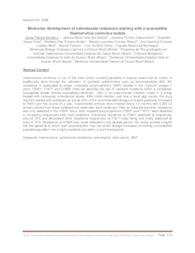Molecular development of oxfendazole resistance starting with a susceptible Haemonchus contortus isolate.
Molecular development of oxfendazole resistance starting with a susceptible Haemonchus contortus isolate.
Autoria: MONTEIRO, J. P.; SANTOS, J. M. L. dos; VASCONCELOS, J. F.; FROTA, G. A.; ANDRÉ, W. P. P.; RIBEIRO, W. L. C.; MELO, A. C. F. L.; TEIXEIRA, M.; VIEIRA, L. da S.; BEVILAQUA, C. M. L.
Resumo: Abstract: Haemonchus contortus is one of the main small ruminant parasites in tropical areas and its control is traditionally done through the utilization of synthetic anthelmintics such as benzimidazoles (BZ). BZ resistance is associated to single nucleotide polymorphisms (SNP) located in the Beta-tubulin isotype 1 gene: F200Y, F167Y and E198A. Here we describe the rise of resistant mutations within a completely susceptible isolate (Inbred-susceptible-Edinburgh - ISE) in an experimental infection model in 3 sheep treated with increasing oxfendazole doses. After initial infection and rise in fecal egg counts, the drug regimen started with subdoses as low as 30% of the recommended dosage and were gradually increased to 100% over the course of a year. Experimental animals were infected every 1.5 months with 5,000 L3 larvae cultured from feces collected one week after each treatment. After an initial period when resistance was only detected in the F200Y locus, both resistant polymorphisms (F200Y and F167Y) were detected in increasing frequencies after each treatment. Eventually resistance at F200Y stationed at frequencies around 70% and decreased while resistance frequencies at F167Y kept rising and finally stationed at around 75%. Resistance at E198A was never detected in the studied period. Our study provide insights into the speed as to which each polymorphism may rise as BZ dosage increases converting a susceptible parasite population into a highly resistant one within a short time period.
Ano de publicação: 2017
Tipo de publicação: Resumo em anais e proceedings
Unidade: Embrapa Caprinos e Ovinos
Observações
1 - Por padrão são exibidas publicações dos últimos 20 anos. Para encontrar publicações mais antigas, configure o filtro ano de publicação, colocando o ano a partir do qual você deseja encontrar publicações. O filtro está na coluna da esquerda na busca acima.
2 - Para ler algumas publicações da Embrapa (apenas as que estão em formato ePub), é necessário ter, no celular ou computador, um desses softwares gratuitos. Sistemas Android: Google Play Livros; IOS: iBooks; Windows e Linux: software Calibre.
Acesse outras publicações
Acesse a Base de Dados da Pesquisa Agropecuária (BDPA) para consultar o acervo completo das bibliotecas da Embrapa.

